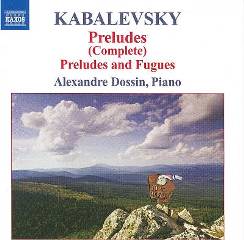Dmitry Kabalevsky - Preludes and Fugues (Dossin) [2009]
Dmitry Kabalevsky - Preludes and Fugues (Dossin) [2009]

4 Preludes, Op. 5 1. No. 1. Semplice 00:01:33 2. No. 2. Vivo e leggiero 00:00:43 3. No. 3. Moderato quasi andante 00:02:47 4. No. 4. Allegro molto 00:01:17 24 Preludes, Op. 38 5. No. 1. Andantino 00:01:36 6. No. 2. Scherzando 00:00:40 7. No. 3. Vivace 00:01:34 8. No. 4. Andantino 00:01:51 9. No. 5. Andante sostenuto 00:02:08 10. No. 6. Allegro molto 00:01:14 11. No. 7. Moderato e tranquillo 00:02:05 12. No. 8. Andante non troppo - Semplice e cantando 00:02:14 13. No. 9. Allegretto scherzando 00:01:21 14. No. 10. Non troppo allegro, ma agitato - Recitando, rubato 00:03:30 15. No. 11. Vivace scherzando 00:00:57 16. No. 12. Adagio 00:03:36 17. No. 13. Allegro non troppo 00:02:51 18. No. 14. Prestissimo possibile 00:02:13 19. No. 15. Allegro marcato 00:00:47 20. No. 16. Allegro tenebroso 00:01:44 21. No. 17. Andantino tranquillo 00:02:02 22. No. 18. Largamente con gravita 00:01:10 23. No. 19. Allegretto 00:00:59 24. No. 20. Andantino semplice 00:02:28 25. No. 21. Festivamente (non troppo allegro) 00:01:55 26. No. 22. Scherzando. Non troppo allegro 00:01:58 27. No. 23. Andante sostenuto 00:02:14 28. No. 24. Allegro feroce 00:03:52 6 Preludes and Fugues, Op. 61 29. Prelude and Fugue No. 1 in G Major, "A Summer Morning On The Lawn" 00:03:36 30. Prelude and Fugue No. 2 in C Major, "Becoming A Young Pioneer" 00:02:36 31. Prelude and Fugue No. 3 in E Minor, "An Evening Song Beyond The River" 00:03:31 32. Prelude and Fugue No. 4 in A Major, "At The Young Pioneer Summer Camp" 00:02:39 33. Prelude and Fugue No. 5 in C Minor, "The Story Of A Hero" 00:05:43 34. Prelude and Fugue No. 6 in F Major, "A Feast Of Labour" 00:04:28 Alexandre Dossin, piano
Drawing on the Chopin model of alternating major and minor keys, as well as on Russian folk melodies, Kabalevsky’s 24 Preludes (1943–4) find the composer’s writing at its most distinctive. They are coupled with the early 4 Preludes (1927), in which the influence of Prokofiev is seldom far away, and the Preludes and Fugues (1958–9), six widely contrasting and expressive preludes yoked to their traditional fugal partners. --- naxos.com
Barry Brenesal, in 31:4, found Christoph Deluze's playing of these pieces on a Pavane recording "lethargic." I'm in no position to agree or disagree, since, in truth, this new Naxos release is my first exposure to Kabalevsky's works for solo piano. So, I shall give this my best shot.
The four Preludes, op. 5, with which Dossin opens his program were written in 1927, and are among the composer's earliest published works. The clearest influences would seem to be Scriabin and Debussy, though elements of jazz and a pithy, almost pointillistic minimalism are also in play. In 1943, Kabalevsky set out to compose a set of 24 preludes following Chopin's model of alternating major and relative minor keys--C-Major/A-Minor--as opposed to Bach's model of alternating major and parallel minor keys--C-Major/C-Minor. By this time, Kabalevsky would surely have had an opportunity to familiarize himself with Shostakovich's 24 Preludes, op. 34, written 10 years earlier. And indeed, a few of the darker preludes in Kabalevsky's opus do call Shostakovich to mind. But in large measure, Kabalevsky's writing strikes me as closer in style to that of Prokofiev. There's an almost singable tunefulness to many of the preludes, peppered of course with sharp dissonances and brief bitonal excursions to jazz and juice things up. The Prelude No. 14, marked Prestissimo possible, is a dead ringer for the concluding "wind on the grave" movement of Chopin's "Funeral March" Sonata. I found myself really enjoying these pieces. They're quite varied in rhythm, melody, and keyboard technique, so that monotony never sets in; and they run the gamut from jaunty and jokey, to minatory, to ingenuously touching.
Fifteen years later, this time likely inspired by Shostakovich's 24 Preludes and Fugues, op. 87 (1950-51), Kabalevsky embarked on a similar project in 1958. Whether or not he actually intended to write a prelude and corresponding fugue in each of the major and minor keys, in the event, he left off after composing only six, which were published as op. 61. Of greater seriousness and gravitas than the op. 38 Preludes, Kabalevsky's Six Preludes and Fugues are nonetheless also quite beautiful and affecting.
Having no other recordings of this music at hand for comparison purposes, I can only report my reactions to this recording and to Alexandre Dossin's playing. Both, I'm happy to say, are positive. The Brazilian-born pianist won both first prize and the special prize at the Martha Argerich International Piano Competition in 2003, and has appeared in concert with a number of leading orchestras and conductors. Dossin succeeds in imbuing each of these pieces with its own distinct character and, in so doing, captures their unique essence. I detected no technical fumbles or stumbles; and the recording--made in December 2007 at Beall Concert Hall, University of Oregon School of Music and Dance, where Dossin is on the faculty--is excellent by an order of magnitude over a couple of recent Naxos discs I've heard that were recorded in Russian venues.
Strongly recommended; but you may have to do some fast talking to reassure your patriotic friends of where your loyalties lie if they happen to notice the photo of the Sign of Leninist Young Communist League of the Soviet Union on the cover. --- Fanfare, Jerry Dubins, amazon.com
download (mp3 @320 kbs):
yandex 4shared mega mediafire zalivalka cloudmailru uplea








